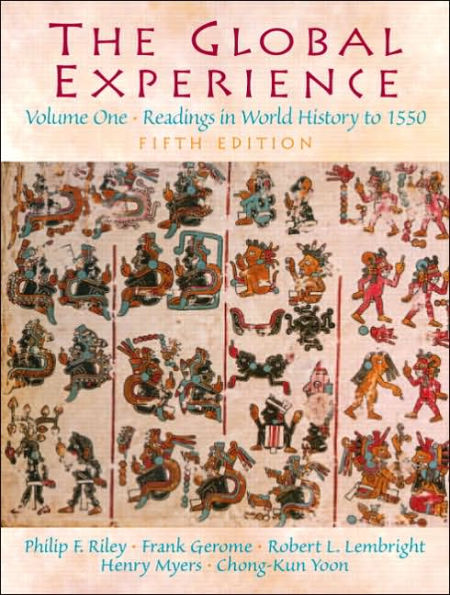Table of Contents
I. EARLY CIVILIZATIONS.
Global Conceptions of the Cosmos and Creation.
1. The Egyptian Creation Story:
The Creation According to Ra. 2. The Hebrew Creation Story: Genesis. 3. Pan Ku, China's Creation Mythology. 4. A Hindu Creation Story:
Rig Veda. 5.Hesiod, Theogony and Works and Days. 6. Mayan Creation Story: Popol Vuh.
Culture Heroes in Early Epics.
7. The Epic of Gilgamesh. 8. Homer, The Odyssey. 9. The Epic of Sunjata.
Law in the Ancient Near East: Babylonian, Hittites and Hebrews.
10. The Babylonian Code of Hammurabi. 11. Hittite Laws.
Origins of Writing in West Asia; the Scribal Profession
12. Sumerian Schoolboy. 13. Papyrus Lansing: A Schoolbook.
Challenges to Egyptian Tradition.
14. Hatshepsut: Successful Female Pharaoh. 15. The Hymn to Aton and Psalm 104. 16. Isaiah: Prophet of Doom and Hope.
Military Strategy and Tactics: Assyria and China.
17. Assyrian War Tactics. 18. Sun Tzu [Sunzi],
The Art of War. II. CLASSICAL CIVILIZATIONS.
The Hindu Tradition in Classical India.
19. The Essence of the Universe. 20.
The Laws of Manu.21.
Bhagavad-Gita.22. Duties of a King,
Artha Shastra.23. Hsuan-tsang (Xuanzang), The Land and People of India.
The Buddhist Tradition.
24. Enlightenment of the Buddha. 25. Pure Land Scripture,
Sukhavativyuha. 26. Asoka: The Edict of Asoka.
The Golden Age of Chinese Thought.
27. Confucius,
Analects.28. Taoism [Daoism]:
LaoTzu [Lao Zi]. 29. Legalism: The Writings of Han Fei Tzu [Han Pei Zi]. 30. Mencius, “Humane Government.”
Classical Greece.
31. Sappho,
Lyric Songs.32. Herodotus,
Persian Dialogue.33. Sophocles,
Antigone.34. Thucydides,
Peloponnesian War.35. Xenophon,
The Spartan Constitution.36. Aristotle, Politics.
Roman Contributions to Ideologies of Government and Law.
37. Plutarch,
Numa, the Lawgiver.38. Titus Livy, Heroes of the Early Republic. 39. Polybius, “Why Romans and Not Greeks Govern the World.”40. Marcus Tullius Cicero,
The Laws. Science in the Greco-Roman and Chinese Worlds.
41. The Yellow Emperor,
Nei-ching [
Neijing] (Canon of Medicine). 42. Hippocrates,
On the Sacred Disease. 43. Pliny the Elder,
The Nature Story. III. CHRISTIANITY TO ISLAM.
The Rise of Christianity.
44. The Golden Rule and God's Will. 45. The Writings of St. Paul on Women.
Rome and the Christians.
46. Pliny the Younger,
Letters to Emperor Trajan.47. St. Augustine of Hippo, The Just War. 48. Paulus Orosius,
History Against the Pagans.49. Monastic Life: The Rule of Saint Benedict.
Fusion of Church and State: Byzantine Beginnings.
50. Eusebius, "Life of Constantine." 51. Procopius,
History of the Wars and
The Secret History. The Rise of Islam.
52. The Qur'an. 53. Sayings
(Hadiths) Ascribed to the Prophet: Holy War.
High Point of Islamic Culture.
54. Harun al Rashid and the Byzantine Empire. 55. Kai Kaus, “Scientific Physiognomy and the Purchase of Slaves.”56. One Thousand and One Nights: The Tale of the Fisherman.
IV. MEDIEVAL EUROPE, AFRICA, AND THE EAST.
The Germanic Tribes Succeed the Romans in the West.
57. Gregory of Tours,
History of the Franks.58. Law Code of the Salian Franks.
Feudalism and Chivalry, West and East.
59. The
Nibelungenlied.60.
The Book of Emperors and Kings, “Charlemagne and Pope Leo III.”61. Bahas al-Din Ibn Shaddad, "Saladin:
The Lion of Islam".62. Tsunetomo Yamamoto,
Hagakure (The Way of the Samurai). 63. The Forty-Seven Ronin.
East-West Images and Realities.
64. Liutprand, Bishop of Cremona,
A Mission to Constantinople.65. Memoirs of Usamah Ibn-Munqidh. 66. Sir John Mandeville, “The Land of Prester John.”
Islam and Islam's Enemies.
67. Ibn Battuta in Mali. 68. Ibn Khaldun,
The Muqaddima (The Course of History).69. Martín Fernández de Figueroa, Confronting the Moors in Somalia.
Byzantium: The Later Period of Decay.
70. Micahel Psellus,
Chronographia, “Empress Zoe.”71. Robert of Clari,
The Conquest of Constantinople. Scholasticism, Mysticism, and Humanism.
72. Peter Abelard,
The Story of My Misfortunes.73. St. Hildegard of Bingen,
Know the Ways.74. St. Francis of Assisi, “The Rule of Saint Francis.”
Coping With Deviant Belief: East and West.
75. Pierre de Vaux-de-Cernay, “What Cathars Believe.”76. St. Thomas Aquinas,
Summa Theologica: “Where Heretics are to be Tolerated.”77 William Rubruck,
Journey to Cathay 78. Joan of Arc, The Trial of Joan of Arc.
Medieval Domestic Life in Western and Eastern Europe.
79. The Good Man of Paris. 80.
The Domostroi, Rules for Russian Households in the Time of Ivan the Terrible. Medieval Governments and Societies of China and India.
81. Emperor T'ai-tsung [Taizong]: “On the Art of Government.”82. Sung (Song) China: Imperial Examination System. 83. Chinese Footbinding 84. Murasaki Shikibu,
The Tale of Genji. 85. John Pian del Carpini,
The Tartars. 86. Marco Polo in China.
The Black Death: Christian and Muslim Views.
87. The Black Death in Florence. 88. Ibn Al-Wardi,
An Essay on the Report of the Pestilence.
V. A WORLD IN CHANGE.
The Rise of the Ottoman Empire.
89. Kritovoulos,
History of Mehmed the Conqueror.90. Suleiman the Magnificent and His Courtiers. 91. Vlad Tsepes, “The Impaler”: The Real Dracula or How the Enemy of the Ottomans Became a Legend.
The Rise of Russia.
92.
The Russian Primary Chronicle.93. Heinrich von Staden,
The Land and Government of Muscovy. The Renaissance and Reformation.
94. Niccolò Machiavelli,
The Prince and
The Discourses on Titus Livy.95. Erasmus,
Julius II Excluded.96. Martin Luther at the Diet of Worms, 1521. 97. St. Charles Borromeo:
Instructions to Confessors. Age of Exploration and Expansion.
98. Cheng Ho [Zheng He]: Ming Maritime Expeditions. 99. St. Francis Xavier on the Japanese: “The Best People Who Have Yet Been Discovered.”
Portugal in Asia and Spain in America.
100. The Travels of Mendes Pinto.
Spain in America
101. Christopher Columbus, Journal of First Voyage to America. 102.An Aztec Account of the Conquest of Mexico: The Broken Spears. 103. Pope Paul III, “Indians Are Men.”
104. Bartolomé de las Casas, Destruction of the Indies and “The Only Method of Converting the Indians.”






